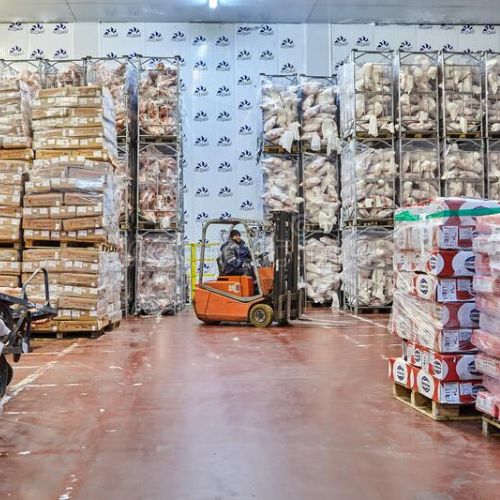
Services at
Vegio Foods Pvt. Ltd.
Warehousing, Distribuition and Food Supply Chain Management
refrigerated Warehousing
Refrigerated warehousing is a vital part of the supply chain for perishable goods. It involves the use of temperature-controlled facilities that maintain specific temperature ranges to preserve the quality and integrity of these sensitive products throughout storage and distribution. Proper temperature and humidity control, storage capacity, safety and security, quality control, and transportation are all critical components of an effective refrigerated warehousing operation.
Transportation is an integral part of refrigerated warehousing, and facilities must work closely with transport providers to ensure that products are moved efficiently while maintaining temperature control. In summary, refrigerated warehousing is a highly specialized field that requires a deep understanding of the unique challenges associated with storing and transporting perishable goods.


non-refrigerated Warehousing
Non-refrigerated warehousing refers to storage facilities that are designed to store products that do not require temperature control to maintain their quality. These types of warehouses are typically used to store dry goods, such as paper products, building materials, electronics, and other non-perishable items.
Non-refrigerated warehouses can come in a variety of sizes and configurations, ranging from small storage rooms to large distribution centers. They are often equipped with loading docks and other features that allow for efficient movement of goods in and out of the facility.
To ensure the safety and security of the products stored in non-refrigerated warehouses, proper inventory management and security protocols are necessary. This includes keeping accurate records of the products stored, monitoring for any signs of damage or deterioration, and implementing security measures to prevent theft or unauthorized access.
refrigerated transportation
Refrigerated transportation refers to the transportation of temperature-sensitive products, such as food, pharmaceuticals, and other perishable items, in vehicles that are equipped with refrigeration units. The purpose of refrigerated transportation is to maintain the quality and safety of these products by ensuring that they are kept at the appropriate temperature throughout the entire shipping process.
Refrigerated transportation can be done using a variety of vehicles, including refrigerated trucks, trailers, and shipping containers. These vehicles are designed to maintain a consistent temperature range, typically between 0°C and 8°C for fresh produce, and between -20°C and -30°C for frozen goods.
Refrigerated transportation plays a critical role in the global supply chain, allowing for the safe and efficient transport of perishable products across long distances. It is essential for industries such as food and pharmaceuticals, which require strict temperature control to ensure the safety and quality of their products.


non-refrigerated transportation
Non-refrigerated transportation refers to the transportation of products that do not require temperature control during shipping. This can include dry goods such as clothing, electronics, and building materials, as well as some types of food and beverages that are shelf-stable and do not require refrigeration. Non-refrigerated transportation can be done using a variety of vehicles, including trucks, trains, ships, and airplanes. These vehicles are designed to protect products from the elements and ensure that they are not damaged during transit.
While non-refrigerated transportation does not require the same level of temperature control as refrigerated transportation, it still requires careful handling and monitoring to ensure that products are not damaged or lost during transit. This includes proper packaging and loading procedures, as well as tracking and monitoring systems to ensure that products are delivered to their intended destination on time and in good condition.

